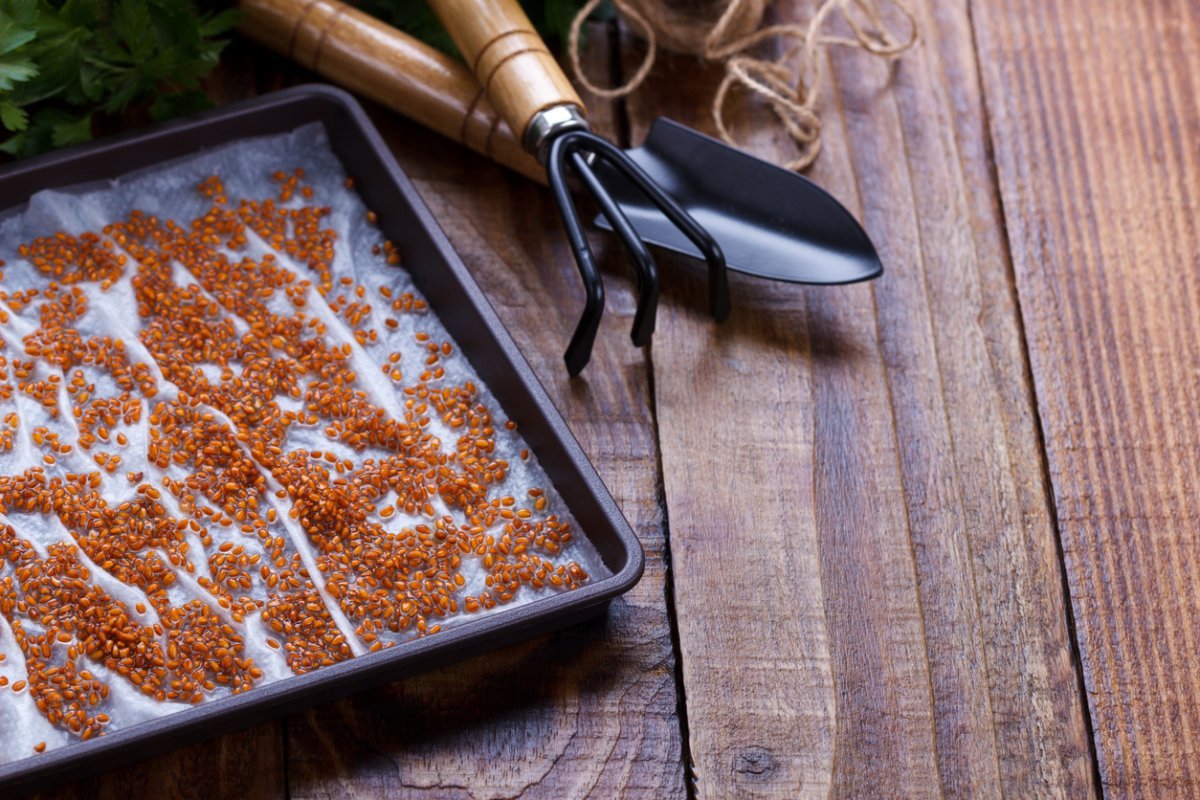I’m a big fan of different seed germination methods. Why? A few years ago, I found an old packet of seeds for one of my absolute favorite heirloom tomatoes. I was so excited that I didn’t bother to get any other tomato seeds that season.
I knew the seeds were a bit older at the time, but they had been in what I thought was a cool, dry, dark space (aka the bottom of a box of gardening supplies in my basement). It didn’t occur to me that these seeds might not sprout, so I put them straight into little containers of soil to get them started indoors.
You can probably guess the rest of the story at this point. I don’t recall how many seeds I tried to start, but I remember almost none of them germinated. Ugh. Fortunately, I discovered this in time to go to my local gardening shop and get some seedlings. And in fact, I found one of my new favorite tomatoes that year, the Black Krim. So the story does have a good ending.
Still, it seemed like it would be wise to try out some seed germination methods to find out early on whether or not my seeds would grow into tomatoes, squash, cucumbers, peppers, and so on. It turns out there are quite a few ways to do this.
Discover 7 top tips for growing, harvesting, and enjoying tomatoes from your home garden—when you access the FREE guide The Best Way to Grow Tomatoes, right now!
3 Seed germination methods that will ensure your garden grows
1. Paper Towel Method: I’m listing this one first because, quite honestly, you probably did this back in 5th-grade science class and just need a refresher. Plus, the technique is fairly similar to many other seed germination methods. Simply place a damp paper towel down on a plate or board, spread your seeds around the towel, and cover them with another damp paper towel. Place them in a dark, warm spot and check on them every day. If the paper towels dry out, just give them a little spray of water. You can also do this in a plastic bag with soaked cotton balls hung in the window, which works really well.
2. Cardboard Pulp Method: This one is very similar to the paper towel method. Grab the cardboard rolls from toilet paper and paper towels or even thin cardboard boxes. Shred the material, then soak it in hot water. From that point, it’s very similar to the paper towel method. Spread out your seeds, keep them in a warm, dark spot, and keep them moist.
3. Water Germination: There is some debate about how well this works. I’ve had some seeds germinate this way, while others did not. I can’t say if that’s because of the method or the seeds. Still, it’s about as easy as it gets. Simply add about an inch of clean, filtered water to a bowl or pie plate and add seeds. Keep the seeds to a single layer and place the container in a warm spot.
Bonus tips for successful seed germination
There are a few things worth pointing out regarding seed germination methods. The first (and I’ll admit I’ve overlooked this a few times) is to read the seed packet and follow the instructions. Some vegetables, especially root crops like carrots or turnips, don’t like to be disturbed once they’ve sprouted.
If you do opt to use soil, be sure to get some designed specifically for starting seeds. The mixture of these is different from what you might get for a raised bed or outdoor garden.
Lastly, don’t fret too much if you have some difficulty getting your seeds to germinate. Sometimes it’s easy. Sometimes it’s disappointing. That’s true no matter which seed germination methods you use.
Do you have a favorite way to germinate seeds? I’d love to get your ideas in the comments below. Discover 7 top tips for growing, harvesting, and enjoying tomatoes from your home garden—when you access the FREE guide The Best Way to Grow Tomatoes, right now!

7 replies on “3 Seed Germination Methods That Don’t Require Soil”
I have placed some seeds that are difficult to germinate in a cup of hot water. I let these rest for 24-48 hrs. Then I plant them. The success rate is incredible.
I have a section of my GARDEN I call kitchen garden… I save the seeds from peppers tomatoes cabbage CORES …carrot tops etc. Plant in soil soggy with H20 and sprout in a warm semi sunny place… they do sprout in short order and I get a great harvest every time. Saves $$ on seed purchases… And the veggies are delightful. I am going to try the tomato slice and check it out!
Another way to start is in damp vermiculite. No soil just vermiculite. Keep it moist and place it in a warm spot
Great idea I’m gonna try it right now since my jalapeño seeds just don’t feel like doing me a favor this year ????
It works great with Campari tomatoes too.
I bought a ripe tomato, cut a slice from middle of mater and placed it in a pot of. light potting soil, watered it and placed it in a warm light place. In a few days I had 50 tomato ???? plants !
How have they progressed? I love this idea.